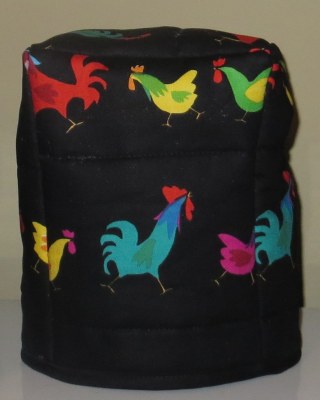This is the third and final tutorial for making appliance covers for your kitchen. Check out part 1 to make a rectangular cover, and part 2 to make a cylindrical cover.
The only other shape I could think of was the stand mixer. What an awkward appliance to cover! But if you make a cover like an upside-down U, it’s not so bad – I promise!
Like the other 2 tutorials, start off with your measurements:
- Maximum circumference: the longest length you can find around the outside of the appliance (keep parallel to the counter). This is the minimum size you need the circumference of the bottom of your cover to be in order to fit on.
- Height: again, go for the maximum – you don’t want it to be like pants that were hemmed too high, you want those “ankles” covered!
- Width and depth: to give you an idea of the shape. Does not have to be exact, just pretty close (the nice thing about fabric is it bends!)
- Any other measurements you think might be helpful: since this is just a general guideline, measure anything else you think may be useful
You’re going to make two identical pieces shaped like a U, with a width about 1″ more than the width you measured (I ended up with 8″) and a height that’s 1/4″ more than the height you measured (I cut mine to be 13.75″). I found it easier to cut a rectangle, then round the top corners. These will be your front and back pieces, and as before you need to cut 3 of each – 1 from outer fabric, one from batting, and one from lining fabric.
Next you need to cut a great big rectangle to sew around the U shape to finish the cover. Measure around the curve of the U’s to get the length. For the depth, add 1″ to your appliance depth measurement. Just as a double check, add all of your measurements together: 2 times the rectangle depth plus 2 times the width of the U – make sure they add up to at least 1″ more than the circumference! If it’s less, make your rectangle deeper. I ended up with a rectangle that was 24″ deep (I can’t tell you the width because I messed it up, and didn’t actually measure it when I fixed it – oops!).
Once you have your outer fabric, lining, and batting cut out, iron the batting onto the outer fabric and quilt all 3 layers together. Then, pin your rectangle around the curve of each of the U’s and stitch in place. To finish it up, add your double-fold bias tape around the bottom, and that’s it!
This same method can be used for other shapes, too – just try to figure out what shape works best and make your own design!
As a bonus, Radar’s mom doesn’t like how hard it is to slide her stand mixer on the countertop – she keeps it in the corner, and it’s really, really hard to pull those sticky feet out to where it’s useable! So she asked me to make a little “coaster” to keep it on that will make moving it around easier. All I did was trace the bottom of the mixer and cut the same 3 layers out with an extra 1/4″ around my tracing. Then I ironed the batting onto the top, put the pieces right sides together, and stitched around the edge, leaving a 3″ opening on one of the straight parts (trust me, you don’t want to try to stitch a curve shut if you can avoid it!). Turn it right side out, quilt the pad, and then stitch around the edge with a scant 1/4″ seam allowance, turning the open edges in.
And now you have a beautiful set of appliance covers to make your kitchen a more cheerful, coordinating place!











